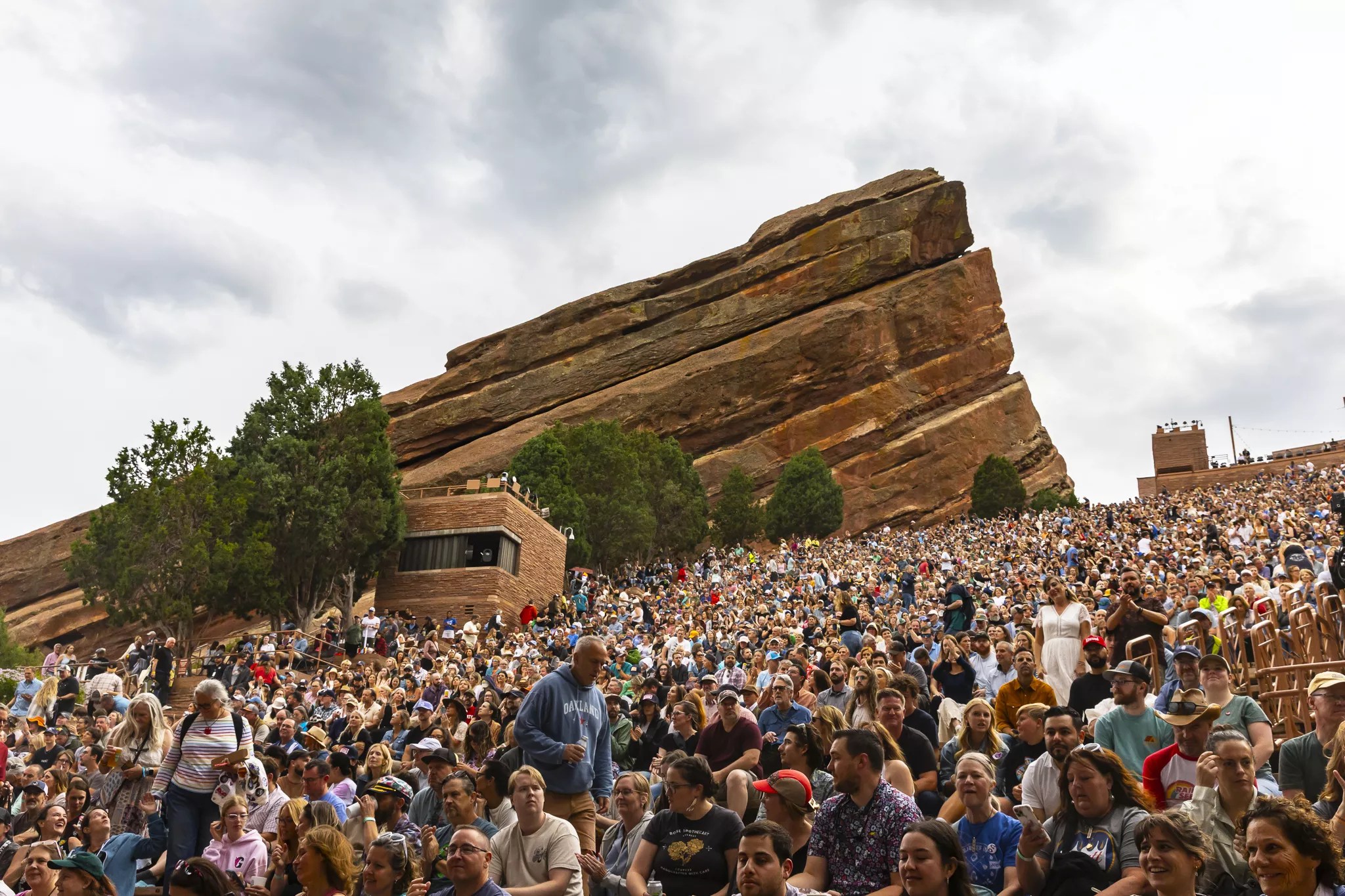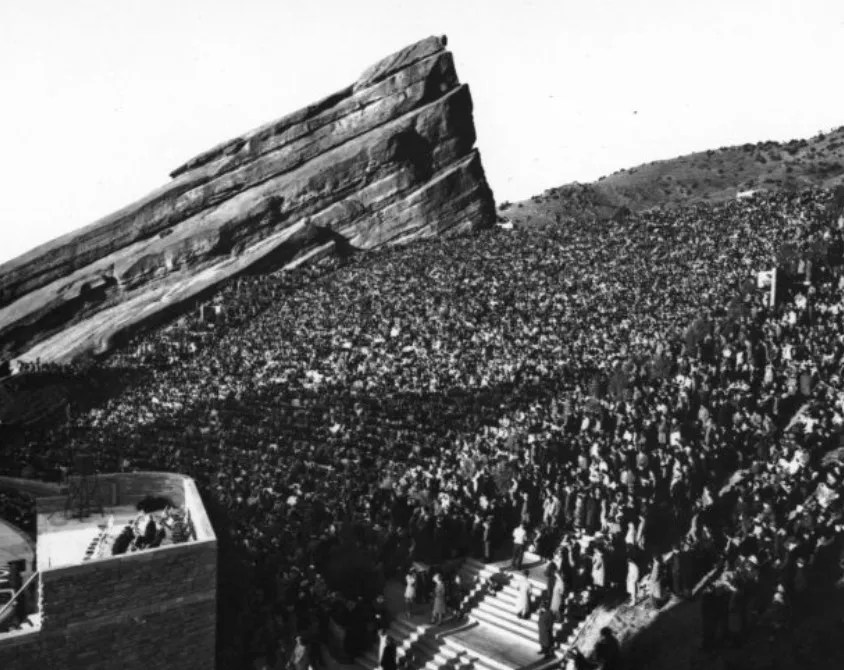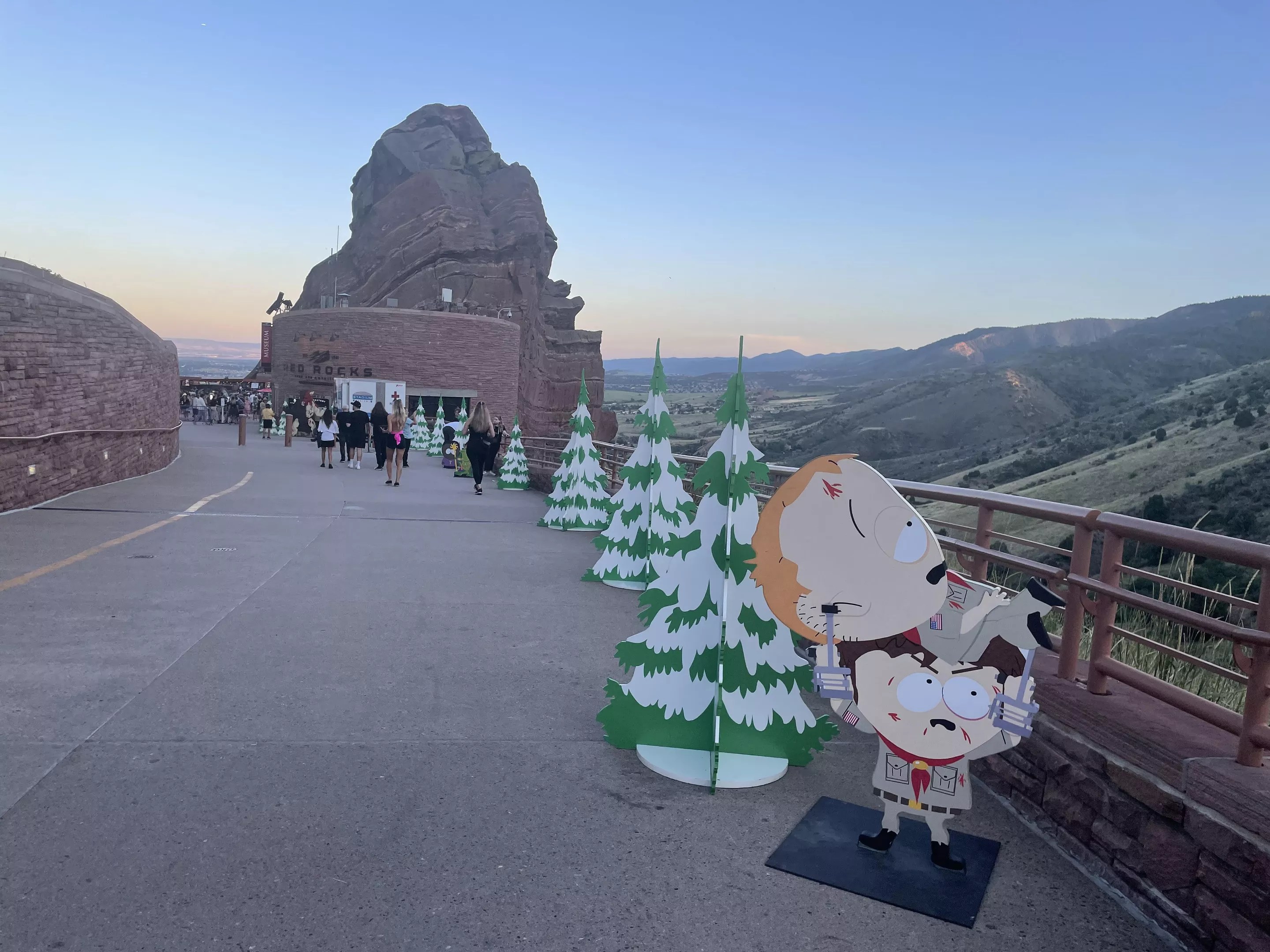
Zach Culver (@zatchmolivesmedia)

Audio By Carbonatix
Red Rocks Amphitheatre is one of the crown jewels of Colorado. It not only draws in visitors from all over the world, making it a top-attended venue in the U.S., but also remains cherished in the hearts of locals. In that respect, it’s in rarified air, topped perhaps only by Rocky Mountain National Park. And in terms of concert history? Nothing can hold a candle to it. Or a lighter. Or a cell phone flashlight, waving in the summer air and cradled by Ship Rock and Creation Rock.
Anyone who’s been to Red Rocks has their own personal “best of” list, of course. For me, it was the first time I saw James Taylor there, way back in 2001. It was my first visit to Red Rocks, and it happened at an American inflection point-only a little over a week before the attack of September 11. The other was much later-the last John Prine show, rescheduled from summer to fall in 2019, only months before his passing in 2020. When he took the Red Rocks stage that final time- backed by the Colorado Symphony, no less-it was clear he knew his time was just about up, which only made the songs he chose more purposeful and poignant.

Red Rocks crowd during Watchhouse’s set.
Photography By: Brandon Johnson (@bjohnsonxar)
It’s what Red Rocks does best: add gravity and atmosphere both to music that already inspires.
Denver, make your New Year’s Resolution Count!
We’re $14,000 away from our End-of-Year campaign goal, with just a couple of days left! We’re ready to deliver — but we need the resources to do it right. If Westword matters to you, please contribute today to help us expand our current events coverage when it’s needed most.
We’re focusing here on Red Rocks once it became Red Rocks, so the first show from 1906-Pietro Satriano and his 25-piece brass band-isn’t listed here. Back then, it was called the Garden of the Titans, and none of the characteristic red-stone rows were yet in-place. Those would come later, in cooperation between the Civilian Conservation Corps and Works Project Administration Depression relief programs in the 1930s. Red Rocks proper wouldn’t come into being officially until 1941.
So this list isn’t a ranking so much as a chronology-and an opportunity to look back and admire that long, strange trip it’s been, to recall how the heart soared. In other words: a love song.

Some things change; the red rocks looming over the crowd haven’t in millions of years.
1941 – Opening Day
On June 15, 1941, Red Rocks Amphitheatre officially launched with speeches from politicians, officials from the Rotary Club and other local luminaries. To honor the Native Americans who held the land sacred, the program opened with a ceremonial Eagle Dance and a Zuni Indian melody. (And America was just about to go to war with the Nazis…so super-woke for the 1940s, right?) In order to spotlight the natural acoustics, noted vocal artists sang, “Home on the Range,” “Ol’ Man River” and the Overture from Offenbach’s “Orpheus in the Underworld.” It wasn’t a concert so much as a community event-but it literally set the stage for all that would come.
1964 – Peter, Paul, and Mary
The folk music of Peter, Paul, and Mary was the drinking straw that broke the camel’s back on July 3, 1964, when the audience at Red Rocks got a little too rowdy and threw at least one beer can at the band onstage. And they weren’t the first-no less than Ray Charles had gotten the same treatment in 1962, and he ended up playing only 45 obligatory minutes before vacating the venue. All this brought about Red Rocks’ alcohol ban, which lasted only two years before being revoked. But the issue of crowd control at Red Rocks was far from over.
1964 – The Beatles
It wasn’t Red Rocks’ first big show, certainly, but the Beatles’ August 26, 1964, performance was the first big show that made rock and roll a centerpiece. While it was reportedly the largest crowd Red Rocks had ever seen up to that point, it was also the only show the Fab Four did stateside on the first American tour that wasn’t sold out. Red Rocks was still in its relative infancy-and so were the “Moptops from Liverpool.” Back then, it cost all of $6 and change for a “ticket to ride,” and it was memorable for both fans and the band alike. Ringo Starr says he recalls getting hits from oxygen containers during the show because of the altitude-but it was the fans who were breathless.
1965 – Johnny Cash
The first country music at Red Rocks came on the sultry night of August 29, 1965. It was sort of like the Grand Ole Opry come West: legend-in-the-making Johnny Cash led the bill, backed by his Tennessee Three, and country stars Tex Ritter, June Carter, the Statler Brothers, and others joined in there. While it’s likely that other country singers had graced the stage in years previous, it’s generally accepted that this show ushered in the long string of country stars to follow.
1968 – Aretha Franklin
With growth and popularity also comes problems for a venue, and Red Rocks is no exception. On August 4, 1968, Aretha Franklin was unintentionally responsible for the first recorded trouble. It’s said that the Queen of Soul always demanded pay right before a show, in cash, which she would stow in her purse, sometimes bringing it on stage with her for safekeeping. This time, for whatever reason, that didn’t happen-so neither did the concert. Franklin took the stage not to sing, but to announce that there’d be no show. The result was Red Rocks’ first riot, as angry fans began to destroy everything they could reach, including a grand piano. The result: a one-year ban on rock shows, the first in Red Rocks history…and not the last.
1971 – Jethro Tull
In the years surrounding Woodstock, many young fans considered it a crime to make music available only to those who paid-which is why literally thousands of un-ticketed people showed up to the Morrison venue fully expecting to enjoy Jethro Tull’s June 10, 1971, show. Denver Police on site tried to escort them to a nearby hillside where they could, in fact, enjoy the music from afar, and many did. But some decided they wanted in anyway, and rushed the gates. Authorities overreacted, dropping tear gas out of helicopters to quell the crowd. But treating a concert like a war zone only succeeded in, well, creating a war zone. Reports at the time suggest that the tear gas had the opposite of its intended effect, as crowds began attacking the DPD with rocks, bottles, or anything handy. Even more amazing? Jethro Tull still played a full show, even with tear gas wafting up onto the stage and the riots continuing. Lead singer Ian Anderson started the show by greeting the audience with “Welcome to World War Three!” That’s rock and roll, baby. And also the end of rock shows at Red Rocks for five years.
1974 – John Denver
In the early to mid 1970s, when rock shows were verboten at Red Rocks Amphitheatre, comparably gentler pop like that of John Denver was still given the okay. And it feels right that it was one of Colorado’s favorite adopted sons who did the first four-night stand at Red Rocks. Promoters and venue managers both had learned many lessons from the Tull experience from a few years before, and one of those was to spread an artist’s visit over multiple nights if fan interest demanded it. So while it wasn’t John Denver’s first appearance at Red Rocks (that happened back in ’72), it was the forerunner of multi-night events with such bands as Widespread Panic…(not to be mistaken with the lower-case widespread panic of earlier shows).
1978 – Grateful Dead
Perhaps surprisingly, it took the Grateful Dead until 1978 to first come to Red Rocks-whether that had something to do with the rock ban that had only just been lifted in 1976 or not is anyone’s guess. But regardless, the two-night stand on July 7 and 8t, 1978 was not only the Dead’s first Red Rocks experience; it was also Red Rocks’ first foray into the jam-band phenomenon that it would proceed to profoundly embrace.
1983 – U2
One of the most legendary concerts captured on film for movie history was U2’s Under a Blood Red Sky. It was June 5, 1983, that U2, still climbing to the height of their popularity, recorded some songs for their live album, which proved to be so successful that a concert film was later released of the Red Rocks show in its entirety. It’s one of those Red Rocks shows that people still talk about being there for; and it was the first real national look at what Colorado already knew was the coolest outdoor venue in America.
1993 – Blues Traveler
The early ’90s saw what amounted to Red Rocks’ first artist-in-residence: Blues Traveler, every July 4 weekend now thirty-plus years. The only exceptions were 1999, when the declining health of bassist Bobby Sheehan made a cancellation necessary, and 2020, when COVID made the cancellation of nearly everything necessary. But other than that, John Popper and his harmonica and all the band make the trip-and a lot of fans happy-every Independence Day.
1996 – Phish
The Phish ban, unlike the others, was considered “unofficial,” but it still took thirteen years for Phish to be invited back after a riot caused by an overload of fans who brought issues not only to the storied venue, but also (and perhaps more importantly) in the neighboring town of Morrison. A four-night summer run led to illegal camping, drunken disturbances, and general mayhem in what’s usually a pretty sleepy town. It took until 2009 for Phish to return to Red Rocks, and this time, preparations were made..and the Phish “neo-hippie” fans from years previous were now mostly in their thirties and a completely different stage of life.
2016 – Prince Tribute Emily Ferguson
Maybe the most memorable demonstration of the power of Red Rocks was this memorial concert devoted to Prince, who’d just shocked the world in his untimely passing only weeks before. It wasn’t even a concert, really-it was the pre-show to a Film on the Rocks night featuring Purple Rain. But it was a concert in all the right ways, and then some. The crowd was massive and reverent. Poet Suzi Q. Smith kicked off the proceedings, followed by a number of musicians who showed up to pay tribute, including the Flobots, the Denver Gay Men’s Chorus, Wheelchair Sports Camp, Dragondeer, the Heavy Heavies, and several more. Fans sang along, tears were shed, and all the dearly beloved were gathered there to get through this thing called life. It was a moment for which Red Rocks Amphitheatre was absolutely and perfectly meant.
2022 – South Park Concert
Trey Parker and Matt Stone celebrated 25 years of their seminal show South Park with a special two-night show at Red Rocks in August 2022. Cut-outs of the show’s characters, from Eric Cartman to ManBearPig, were scattered throughout the venue, where Governor Jared Polis also came to the stage to declare August 10 as South Park Day. Ween and Primus were both there to perform, and Primus bassist Les Claypool even played the theme song he wrote decades ago. Parker and Stone sang songs from the series, and Alex Lifeson and Geddy Lee of Rush, Stone’s favorite band, came to the stage to perform with the cartoonist. It was a night to remember that you can read more about here.
What are your favorite Red Rocks memories? Share them with us at editorial@westword.com.